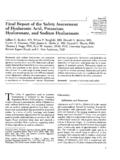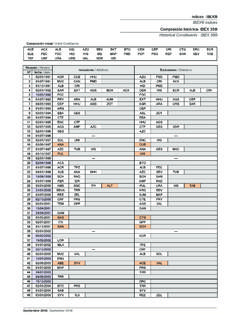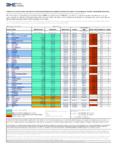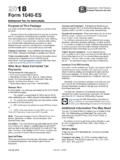Transcription of Other Cancers - Personal Care Products Council
1 Internationalfournal of Toxicology, 27(Suppl. 1):77 142, 2008. Copyright American College of Toxicology ISSN: 1091-5818 print I 1092-874X online DOT: Annual Review of Cosmetic Ingredient Safety Assessments: 2005/20061. The Cosmetic Ingredient Review (CIR) program Expert Ethyl Acetate and Butyl Acetate Panel has assessed the safety of over 1300 cosmetic ingredi Methylene Chloride ents since its inception in 1976. These safety assessments were 2-Methyl-5-Hydroxyethylaminophenol published in the Journal of Environmental Pathology and Tox 2-Methylresorcinol and Resorcinol icology in 1980, the Journal of the American College of Toxi Petroleum Distillate cology, from 1982 to 1996, and since then in the International Phenethyl Alcohol Journal of Toxicology. Polyquaternium- 10. Because information relevant to the safety of ingredients may Retinyl Palmitate and Retinol have become available since early safety assessments were pub Sodium Cocoamphoacetate, Sodium Cocoamphopropionate, lished, the CIR Expert Panel has initiated a re-review process to Disodium Cocoamphodiacetate and Disodium Cocoam uncover such new data.
2 Phodipropionate In some cases, newly available data are largely redundant Sorbic Acid and Potassium Sorbate with the data available in the original safety assessment. In Other Steareth-2,4,6,7,l0,13,15, and -20. cases, new data present new safety issues. If after considering Tallow, Tallow Glyceride, Tallow Glycerides, Hydrogenated the newly available information, the Cifi Expert Panel decides Tallow Glyceride, and Hydrogenated Tallow Glycerides to not reopen a safety assessment, this finding, along with any background material, is summarized and announced publicly. Among these are several cosmetic ingredients used in hair To assure that the scientific community is aware of any new dye Products (4-Amino-2-Hydroxytoluene; m, o, and p information and the decision not to reopen, this Annual Review Aminophenol; Disperse Black 9; 2-Methyl-5-Hydroxyethyl- of Cosmetic Ingredient Safety Assessments is prepared.)
3 Aminophenol; 2-Methylresorcinol; and Resorcinol). Hair dyes A reference list is provided that updates the available pub may be broadly grouped into oxidative (permanent) and direct lished literature and includes any unpublished data made avail (semipermanent) hair dyes. The oxidative dyes consist of pre able since the original safety assessment. The re-review also cursors mixed with developers to produce color, whereas direct captures information on the industry's current practices of in hair dyes are a preformed color. gredient use, updating the data available in the earlier report. Although the safety of individual hair dye ingredients are not Although this material provides the opinion of the CIR Expert addressed in epidemiology studies that seek to determine links, Panel regarding the new data described, it does not constitute a if any, between hair dye use and disease, such studies do provide full safety review.
4 Broad information and have been considered by the CIR Expert The ingredients the CIR Expert Panel reconsidered in Panel. 2005/2006, and determined not to reopen are: In 1993, an International Agency for Research on cancer 4-Amino-2-Hydroxytoluene (IARC) working group evaluated 78 epidemiology literature ci m, o, and p-Aminophenol tations and concluded that Personal use of hair colourants can Arachidyl Propionate not be evaluated as to its carcinogenicity and that occupation Benzallconium Chloride as a hairdresser or barber entails exposures that are probably car Cetearyl, Cetyl, Isostearyl, Myristyl, and Behenyl Alcohol cinogenic (IARC 1993). The IARC report did not distinguish Diazolidinyl Urea between Personal use of oxidative/permanent versus direct hair Disperse Black 9 dyes, or distinguish among the multiple chemical exposures in DMDM Hydantoin addition to hair dyes to which a hairdresser or barber might be exposed.
5 Rollison et al. (2006) reviewed the available epidemiology Received 25 July 2007; accepted 14 November 2007. literature published since 1992. The authors found that hair dye Reviewed by the Cosmetic Ingredient Review Expert Panel. Ad exposure assessment ranged from ever/never use to informa dress correspondence to F. Alan Andersen, Cosmetic Ingredient Re tion on type, color, and duration and frequency of use. The au view, 1101 17th Street, NW, Suite 412, Washington, DC 20036, USA. thors found insufficient evidence to support a causal association 77. 78 COSMETIC INGREDIENT REVIEW. between Personal hair dye use and a variety of tumors and can and lymphoid neoplasm using data from a European multicenter cers. The review highlighted well-designed studies with an ex case-control study. posure assessment that included hair dye type, color, and fre quency or duration of use, which found associations between Other Cancers Personal hair dye use and development of acute leukemia, blad Takkouche et al.
6 (2005) included breast cancer and childhood der cancer , multiple myeloma, and non-Hodgkin's lymphoma. Cancers in their meta-analysis. Efard et al. (2005) studied the These findings, however, were not consistently observed across association between the use of hair-coloring agents the month studies. before or during pregnancy with childhood brain tumors in 1218. The CIR Expert Panel did specifically note reports from a cases between 1976 and 1994. Heineman et al. (2005) studied case-control study (Gago-Dominguez et al. 2001, 2003), which 112 women in Nebraska newly diagnosed with brain cancer did suggest a possible genetically susceptible subgroup, which (glioma). McCall et al. (2005) reported on the relationship be detoxify arylamines to a lower degree than the general popula tween childhood neuroblastomas and maternal hair dye use in tion. The study authors hypothesized that this subgroup may be 538 children born between 1992 and 1994 in the United States at greater risk of bladder cancer from hair dye exposure.
7 Rol and Canada. lison et al. (2006) noted that these results were based on small sample sizes. Other Diseases Several studies published since 2003 also have been consid Park et al. (2005) reported an occupational case-control study ered. Discussion of the available hair dye epidemiology data is of neurodegenerative diseases, including Alzheimer's disease, also available at ! presenile dementia and motor neuron disease. In considering all these data, the CIR Expert Panel concluded Hair Dye Epidemiology that the available epidemiology studies are insufficient to con Bladder cancer clude there is a causal relationship between hair dye use and can Andrew et al. (2004) reported a case-control study of New cer and Other end points. The Expert Panel also stated that use Hampshire residents whose bladder Cancers were entered into a of direct hair dyes, although not the focus in all investigations, state registry from 1994 to 1998.
8 A follow-up study by Kelsey appears to have little evidence of an association with adverse et al. (2005) examined the links between those bladder can events as reported in epidemiology studies. However, direct hair cer cases with an inactivated tumor suppressor gene (TP53) dyes are a diverse group of chemicals and the determination of and various exposures. Huncharek and Kupelnick (2005) per safety may hinge on Other safety test data. formed a meta-analysis of six case-control and one cohort study. The Panel recognizes that hair dye epidemiology studies do Takkouche et al. (2005) performed a meta-analysis of the An not address the safety of individual hair dyes, but is concerned drew et al. (2004) study and nine Other Personal use case-control that studies have demonstrated an association between use of or cohort studies. Ji et al. (2005) reported a cohort occupational oxidative/permanent hair dyes and some cancer endpoints.
9 The study not included in the above meta-analyses. Kogevinas et al. Panel, therefore, strongly supports the need to replicate these (2006) presented evidence from a case-control study in Spain. studies, along with further studies to examine the possibility of Lin et al. (2006) presented a case-control study of Personal per susceptible subpopulations. manent hair dye use. Serretta et al. (2006) reported preliminary results from a multicentric study. REFERENCES. Andrew. A. S., A. R. Schned, J. A. Heaney, and M. R. Karagas. 2004. Bladder Lymphoma and Leukemia cancer risk and Personal hair dye use. lot. J. cancer 109:581 586. Rauscher et al. (2004) reported a case-contol Benavente, Y., N. Garcia, E. Domingo-Domenech, T. Alvaro. R. Font, Y. Zhang and S. de Sanjose. 2005. Regular use of hair dyes and risk of lymphoma in study of adult acute leukemia. Zhang et al. (2004) and Zheng Spain.
10 Mt. J. Epiderniol. 34:1118 1122. et al. (2004) examined the relationship of hair dye use or diet de Sanjose, S., Y. Benevente, A. Nieters, et al. 2006. Association between per with non-Hodgkin's lymphoma in a case-control study in Con sonal use of hair dyes and lymphoid neoplasms in Europe. Ant. J. Epidensiol. necticut. Takkouche et al. (2005) reported a meta-analysis of re 164:47 55. ports of hematopoietic Cancers , including that by Rauscher et al. Efird, J. T., E. A. Holly, S. Cordier, B. A. Mueller, E Lubin, G. Filippini, R. Pens Bonet, M. McCredie, A. Arslan, P. Bracci and S. Preston-Martin. 2005. Beauty (2004) and Zhang et al. (2004) and 17 Other studies. Mester product-related wxposures and childhood brain tumors in seven countries: et al. (2005) reviewed 10 epidemiology studies regarding the Results from the SEARCH International Brain Tumor Study. J. Neura-OSncol.







